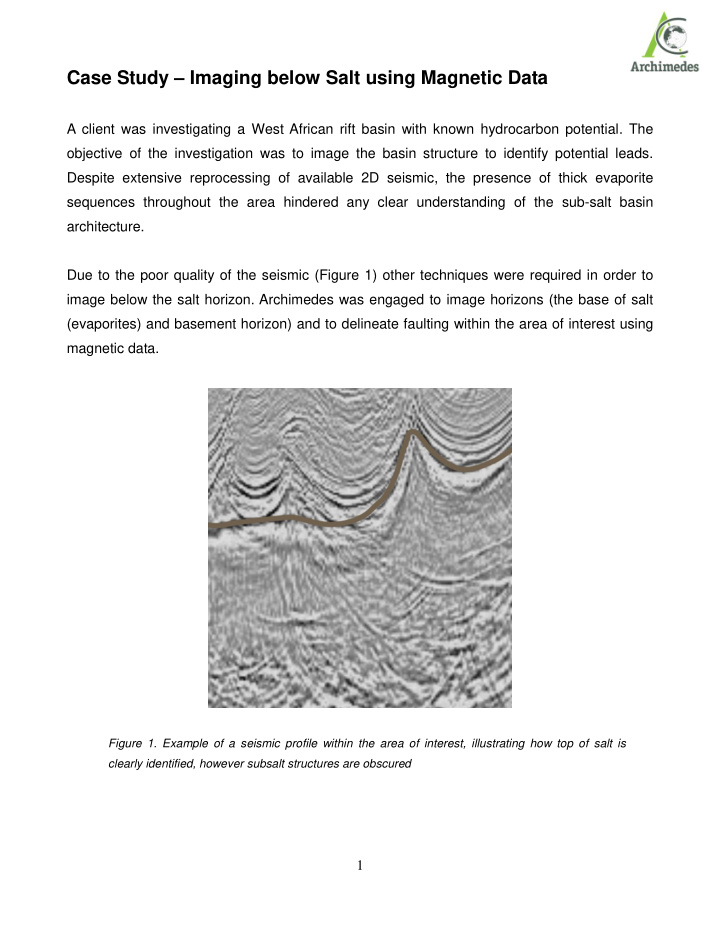



Case Study – Imaging below Salt using Magnetic Data A client was investigating a West African rift basin with known hydrocarbon potential. The objective of the investigation was to image the basin structure to identify potential leads. Despite extensive reprocessing of available 2D seismic, the presence of thick evaporite sequences throughout the area hindered any clear understanding of the sub-salt basin architecture. Due to the poor quality of the seismic (Figure 1) other techniques were required in order to image below the salt horizon. Archimedes was engaged to image horizons (the base of salt (evaporites) and basement horizon) and to delineate faulting within the area of interest using magnetic data. Figure 1. Example of a seismic profile within the area of interest, illustrating how top of salt is clearly identified, however subsalt structures are obscured 1
ARCHIMEDES APPROACH – Energy Spectral Analysis (ESA) for Horizon Interpretation Archimedes employed Energy Spectral Analysis (ESA) for horizon interpretation to image the base of salt and basement horizons. The ESA Multi-Window Technique was used to define the plateaus that corresponded to these horizons (Figure 2). Based on these plateaus the ESA Moving Window Technique was then used to scan the area of interest enabling the depth and configuration of the horizons to be determined. Figure 2. Example of an ESA Multi-Window Technique result for a single location highlighting two strong plateaus. RESULTS - Energy Spectral Analysis (ESA) for Horizon Interpretation Final results for the Energy Spectra Analysis (ESA) horizon interpretation are shown in Figure 3. The mapping of these surfaces provides an insight into the structural trends of the area. The base of salt horizon with its relatively simple monoclinal dip is in contrast to a more structurally complex basement horizon. The magnetic results clearly show that the sediments below the salt vary considerably and are highly influenced by the basement architecture. The chance of delineating closed structures below the salt is enhanced. 2
Figure 3. A 3D cross section showing the base of salt and basement horizons from ESA interpretation. ARCHIMEDES APPROACH – Automatic Curve Matching (ACM) for Fault Interpretation The faults were mapped using Archimedes’ proprietary Automatic Curve Matching (ACM) technique applied to profiles extracted from the high resolution Total Magnetic Intensity (TMI) grid. By varying the parameters in a range of theoretical models (dyke, plate and edge) and comparing observed and computed values, the location, depth, susceptibility and shape of the magnetic bodies were established. Only solutions with high confidence correlations were accepted. These results were visualized in 3D. Magnetic lineaments were interpreted in planar view looking for continuity of solutions. The lineaments represent faults and other geological features such as dykes and lithological boundaries. Where the lineaments continued both in depth and laterally, they were gridded in 3D as faults. 3
RESULTS – Automatic Curve Matching (ACM) for Fault Interpretation Final results for the Automatic Curve Matching (ACM) shows a series of strong magnetic lineaments occurring over a broad depth range. The results show a series of lineaments, trending NW, NE and NS. Figure 4 shows interpreted lineaments with faults gridded in 3D. Figure 4. Magnetic lineament interpretation with 3D fault surfaces. SUMMARY The Archimedes approach to magnetic interpretation resulted in the base of salt and the basement horizons being defined and mapped in an area where seismic imaging was struggling to provide definitive answers. A better understanding of the nature of the basin architecture was attained; identifying several potentially prospective basement structures. Feedback received from the client indicted that the base of salt and basement horizons correlated with available well data. The results also validated and further refined the proposed leads. This reduced the uncertainties that existed in the area, and enhanced the overall prospectivity of the basin below the salt. 4
The lineament identification added valuable information for the understanding of the structural geology of the area of interest. It has reduced exploration risk, by allowing for the better identification of possible structural traps, along with the possibility of detecting where seals may be breached by faults. 5
Recommend
More recommend